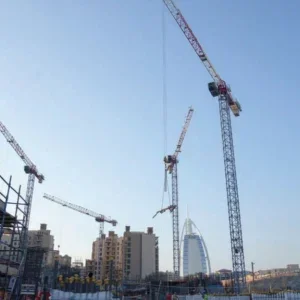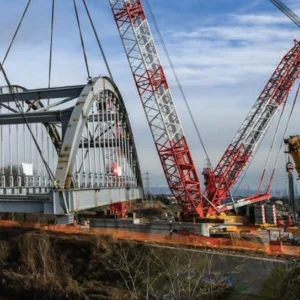Lake Michigan, Wisconsin
In 2008, We Energies began construction on a new air quality control system at one of its Lake Michigan power plants, scheduled to be completed later this year. Dawes has provided as many as 20 cranes at a time for the site.
Dawes’ cranes were on-site from the outset — rough terrain cranes from 65-135USt and crawlers from 175- 660USt capacities, doing everything from steel erection to placing new ductwork and chimney components. A Manitowoc 18000 crawler crane (660USt) with an added MAXER was key to saving money on the project, increasing the crane’s base capacity to do the required work while reducing cost.
Originally, project engineers handling the job wanted to hire a Manitowoc 888 crawler with a RINGER attachment to set the ductwork across a bluff on the shore of Lake Michigan, where the power plant is located. Adding a ringer attachment and pedestals to a crane distributes the load over a larger area and can increase the lifting capacity dramatically. But the cost and time delay can be dramatic, too. The large ringer attachment must be transported onto the job site, and a foundation must be built to support the ringer’s pedestals.
Meeting on the We Energies site with the engineers, Dawes formulated a plan using their Manitowoc 18000 that was already on the site. By adding a MAX-ER attachment and reconfiguring the boom, the customer could save hundreds of thousands of dollars in rental fees alone. All in all, Dawes crane experts were able to save We Energies nearly $1m in crane rental fees by selecting exactly the right cranes.
San Antonio, Texas
Texas Crane Services used a Grove GMK7550 all terrain to dismantle a dome in the roof of The Tobin Center for the Performing Arts’ in downtown San Antonio, Texas, for a renovation project.
The four roof sections, which ranged from 5-10USt, were dismantled in place and lifted out by the GMK7550.
Texas Crane Services crane operator John Dalton said they chose the GMK7550 primarily for its reach. "The challenge of the job was to take the roof apart without damaging the rest of the historic structure," said Dalton. "We could not position the crane very close to the building, so the crane had to be able to reach across the building."
The GMK7550 features a 197ft main boom, but when rigged with a luffing jib and inserts it can achieve a maximum tip height of 430ft.
For the Tobin Center job, Texas Crane’s GMK7550 operated at radii that ranged from 90ft to 180ft, the GMK7550 was configured with 115ft of main boom and 161ft of luffing jib.
The crane was also configured with Grove’s Mega Wing Lift attachment to give greater rigidity to the boom and to accommodate increased counterweight.
The GMK7550 remained on The Tobin Center for the Performing Arts’ project for two weeks. When the renovation is complete, the domed roof will be reassembled and returned to the building for its reopening in 2013.
Boston, Massachusetts
AmQuip’s Boston branch has bought one of Liebherr’s innovative LTC 1045-3.1 city cranes. The ultra-compact design of this model, coupled with the movable cab, were the key drivers behind AmQuip’s purchasing choice. To work in the narrow streets and alleys of Boston, AmQuip was looking for maximum lifting power in a minimum sized machine.
The three-axle 50USt (45t) crane has all terrain capability, but is also compact enough for industrial applications inside warehouses and production halls.
Unlike conventional all terrain cranes, the LTC 1045-3.1 has a single cab for both crane operations and driving. A telescopic arm moves the cab from road driving position at the front of the vehicle to an elevated position for crane operations, to give the operator a much better and broader view of the job site.
Jack Good, manager of AmQuip’s Boston operations, says: "Whether it is setting glass or working over a foundation hole, the operator will have much better views of the workers around the crane. We are confident that this will be a highly utilized crane that customers specifically call for," Good says.
Cincinnati, Ohio
US hire firm Maxim Crane Works is using Terex Cranes’ new Transfer Masts with two newly purchased SK575-32 hammerhead tower cranes for construction work on a hospital expansion project.
The Transfer Mast sections are designed to allow components of Terex’s Comedil luffers and Peiner hammerheads to be used together.
Work on the site required cranes with a minimum freestanding under-hook of 214ft, due to wind load rating requirements of 45mph in-service and 94mph out-of-service mandated in the city of Cincinnati.
Maxim’s tower crane division already owned 100 tower cranes, all of which are Terex cranes. With most of these being hammerhead tower cranes it has nearly 1,000 300tm-400tm hammerhead tower crane sections in its yard, along with 150 500tm hammerhead tower crane sections and 80 tower sections for its four existing luffing jib and flat-top tower cranes.
Tower operations manager for Maxim Crane Works, Matt Hyden, says that the ability to use the firm’s existing heavy-duty tower sections means greater flexibility for the firm’s fleet of hammerhead tower cranes in states with tough wind load requirements. He said: "Before, we had to pass on these types of jobs, since we could only reach 100ft freestanding height in Florida with our hammerhead cranes.
"By gaining the extra height with the transfer masts and heavy duty tower sections, this has opened up markets that were previously closed to Maxim Crane. We can get an additional 80ft to sometimes 100ft of freestanding height by mixing tower sections with the transfer masts."






